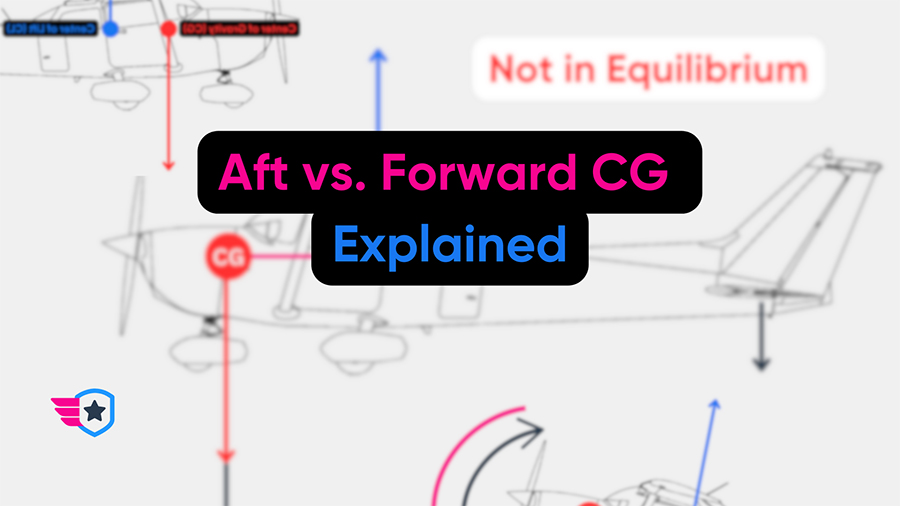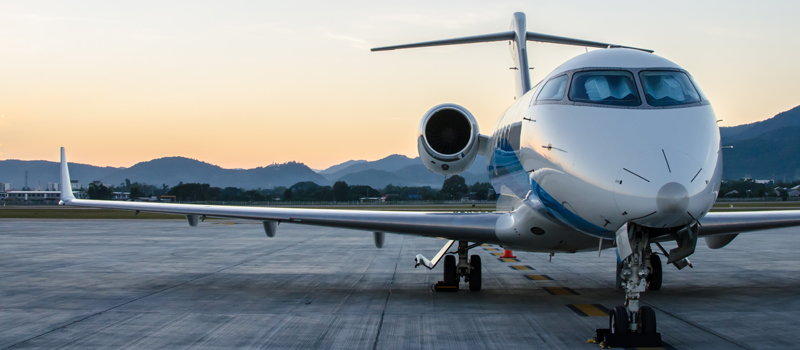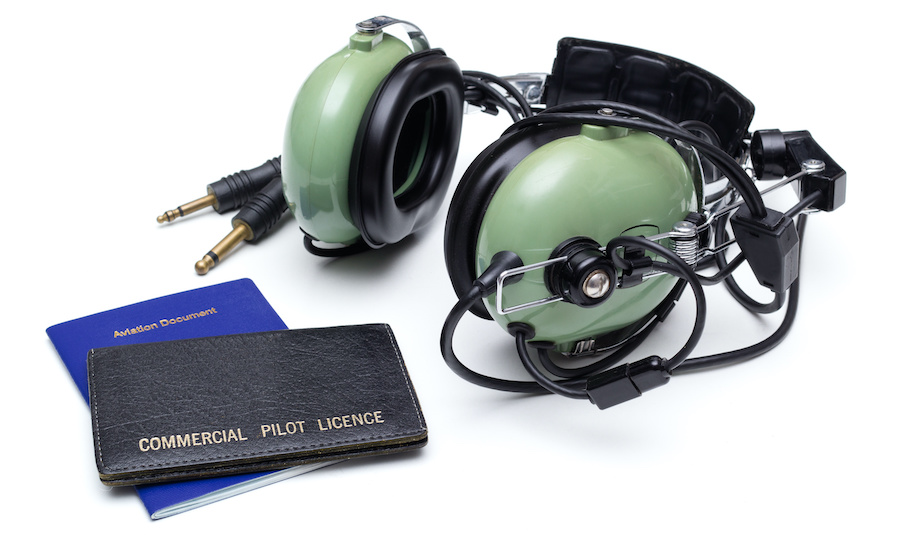Today we’re tackling a crucial but often misunderstood topic in aviation: Center of Gravity, or CG for short.
You’ve probably heard of the terms ‘forward CG’ and ‘aft CG.’ But do you know what they really mean? What about how they affect your aircraft’s performance and safety?
We’re about to demystify these terms and dive into the fascinating world of aircraft balance. By the end of this journey, you’ll be an expert at managing CG and appreciating how it shapes your aircraft’s performance and handling.
Here’s a quick summary:
| Forward CG | Aft CG |
| More stable (longitudinal stability) | Less stable (longitudinal stability) |
| Less fuel efficient (more drag) | More fuel efficient (less drag) |
| Higher stall speed (higher Angle of Attack) | Lower stall speed |
| Good stall recovery characteristics | Bad stall recovery characteristics |
Understanding the Center of Gravity (CG)
First things first. What exactly is the Center of Gravity? Simply put, it’s the point where the weight of an aircraft is perfectly balanced. Picture an invisible dot somewhere in your aircraft—around this dot, your aircraft balances.
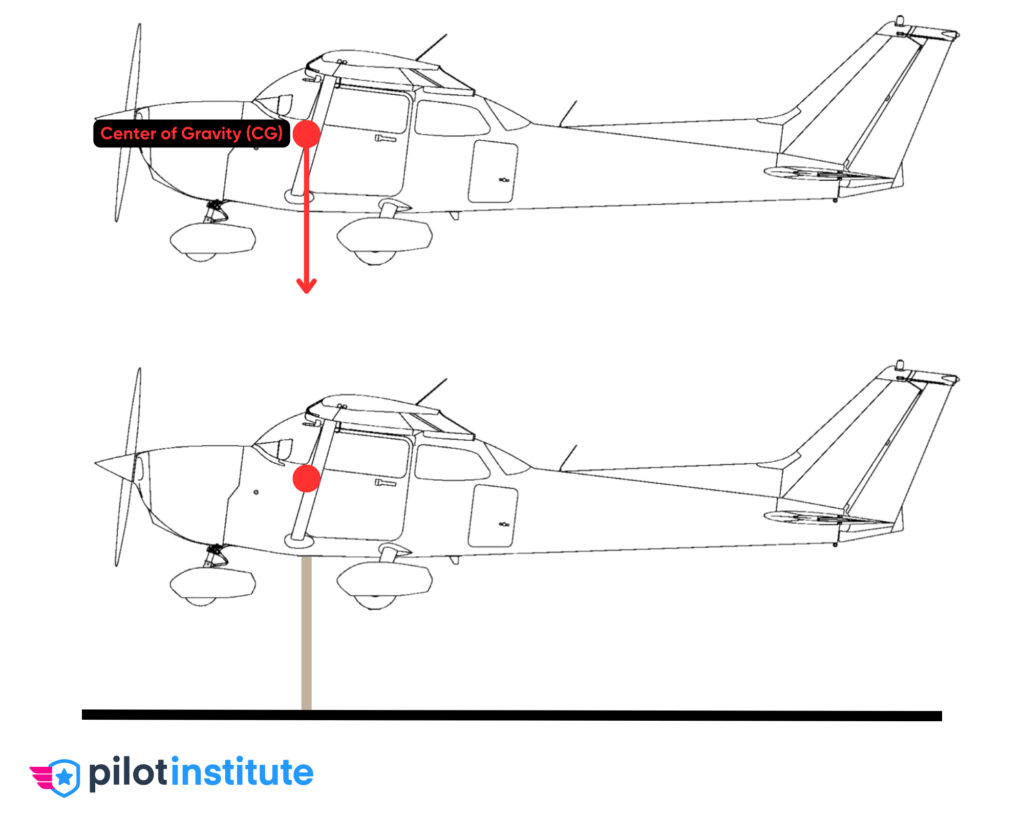
Now, this isn’t static. Load your aircraft differently, and the CG shifts. Add cargo to the back, and the CG moves aft (backward). Load up the front, and it shifts forward. It’s a fluid point, changing with every tweak in the weight (and distribution of weight) of your aircraft.
Why does this matter? Because your CG plays a starring role in how your aircraft performs. From stability and maneuverability to fuel efficiency, it’s the CG pulling the strings behind the scenes.
Understanding the CG (and managing it correctly) is the ticket to safer and more efficient flights. Let’s dive deeper into the intricacies of forward and aft CG.
Forward CG Explained
Forward CG Summary:
- More stable (longitudinal stability)
- Less fuel efficient (more drag)
- Higher stall speed (higher Angle of Attack)
- Good stall recovery characteristics
So, let’s start with a forward center of gravity, or forward CG, as it’s commonly known. This occurs when the weight of your aircraft is tilted more toward the front. It might be due to heavy items stored in the front, or maybe you have little or no payload in the back.
But what does a forward CG mean for you in the cockpit?
Let’s look at all the factors at play.
The lift vector (the blue line) acts through the center of the lift, while the weight vector (the red line) acts through the center of gravity. Think of the center of lift as the lift version of the center of gravity.
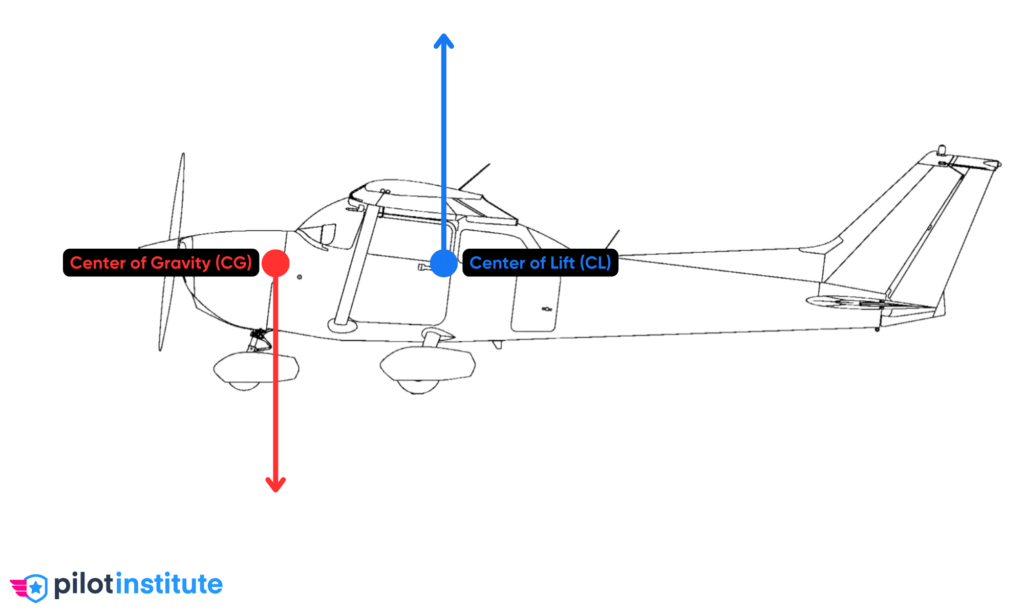
Notice how the CG is forward of the center of pressure? This creates what we call the “lift/weight couple.” Can you guess what kind of pitching moment it produces – up or down?
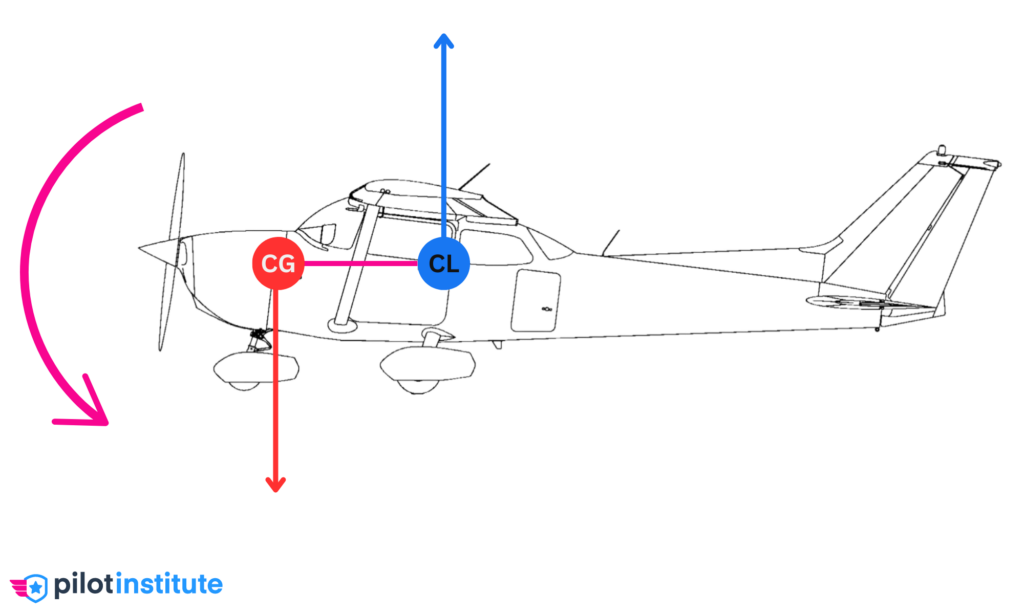
It produces a downward pitching moment. This is great when it comes to stall characteristics – an aircraft with a forward CG will naturally resist a stall and pitch down. A forward CG is not that great if we want to fly straight and level.
Why?
Because we need a continuous force from the horizontal stabilizer to counter-act the nose-down pitching tendency.

This force usually comes from the deflection of the elevator. In other words, you need to pull back on the yoke to overcome the nose-down tendency of the lift/weight couple. The further forward the CG, the more you need to pull back.
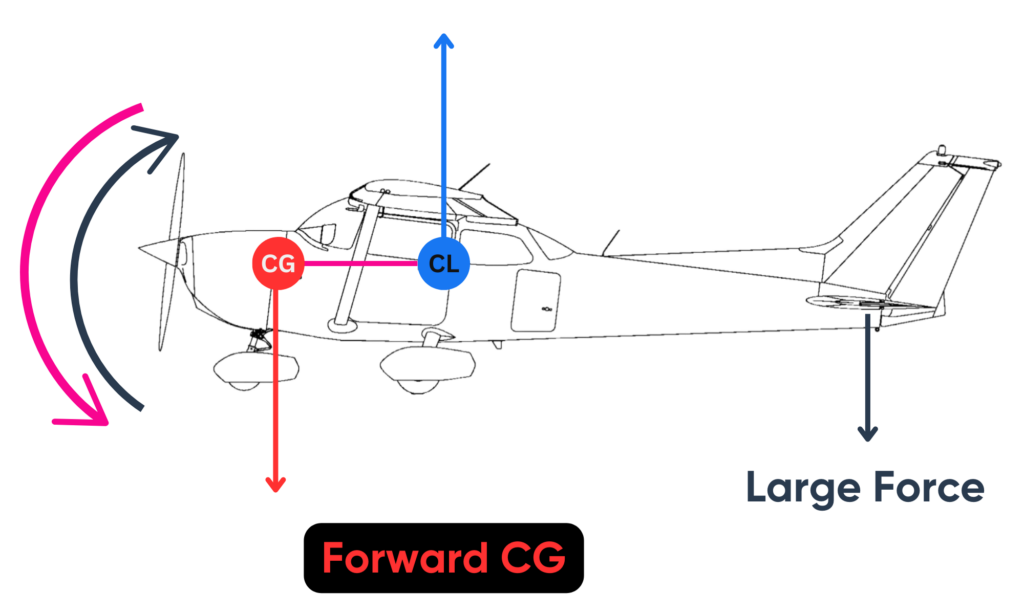
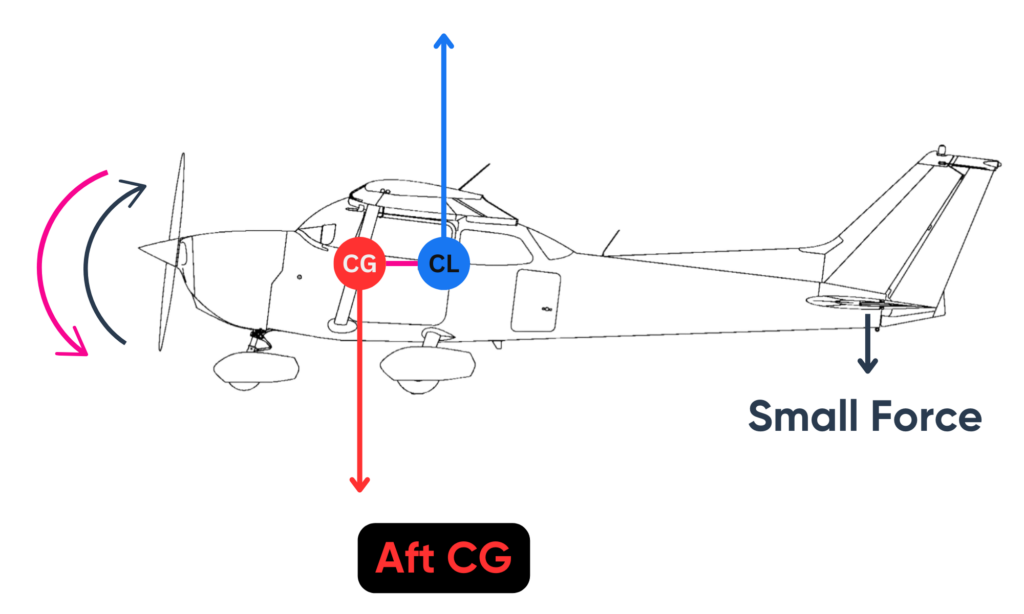
Naturally, this creates drag, and drag isn’t our friend. More drag leads to higher fuel consumption and lower efficiency.
You will, of course, use the trim to keep the elevator in the correct position and relieve any pressure on the control column.
So, how does this affect stability?
For starters, an aircraft with a forward CG is more stable. There are many types of stability, but, generally speaking, stability is your aircraft’s ability to resist motion. In other words, how easily your aircraft pitches, yaws, or rolls.
You will require a larger elevator input to change the pitch of an aircraft with a forward CG – making it more stable and less maneuverable. In other words, the longitudinal (pitch) stability is increased.
But, there’s the issue of efficiency.
With a forward CG, the increase in the force from the horizontal stabilizer creates more drag, leading to higher fuel consumption.
Furthermore, we also need a higher Angle of Attack (AoA) to maintain level flight (which also creates more drag).
This is because, in order for the aircraft to maintain level flight, lift must equal weight.
The issue is that we’re creating a downward force with the horizontal stabilizer that effectively adds to the weight. So now weight is effectively more than lift (actual weight plus downward force).
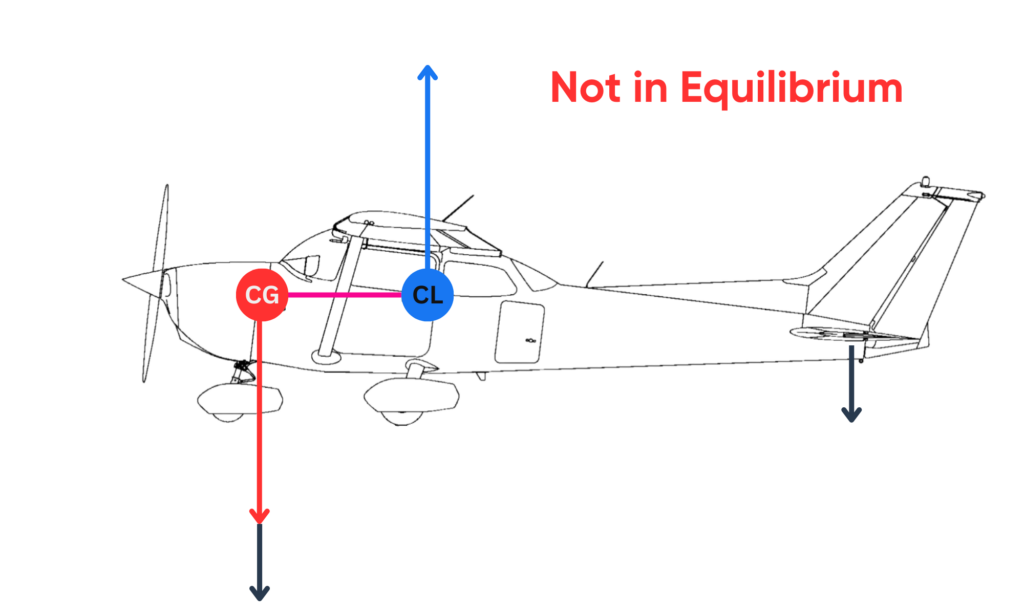
What do we need to do so that lift is equal to effective weight? We need to increase lift. This means we need a higher angle of attack.
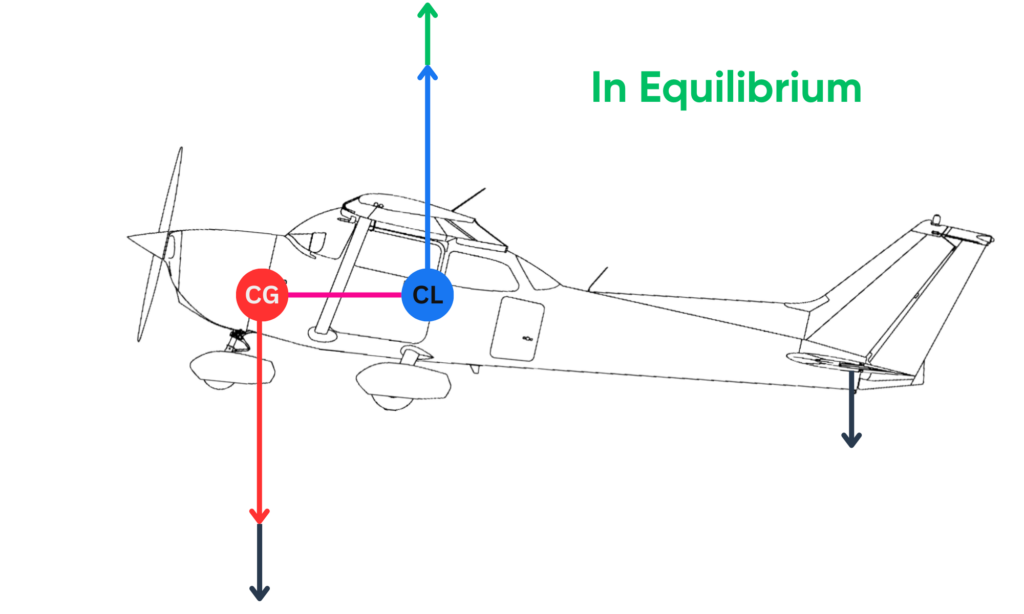
A higher angle of attack creates more drag and reduces our efficiency.
A high angle of attack isn’t necessarily a bad thing – it’s often needed for certain maneuvers and during takeoff and landing. However, consistently needing a high angle of attack during cruise flight (when the aircraft needs to be at its most efficient) leads to higher drag and lower fuel efficiency.
This also leads to an increase in the stall speed because operating at a higher angle of attack brings the aircraft closer to the critical angle of attack (where the aircraft will stall).
So while a forward CG can provide increased stability and better stall recovery characteristics, it has a negative impact on aircraft performance.
Now, let’s turn our attention aft.
Aft CG Explained
Aft CG Summary:
- Less stable (longitudinal stability)
- More fuel efficient (less drag)
- Lower stall speed
- Bad stall recovery characteristics
Now let’s shift our focus to the other end of the spectrum – the aft center of gravity, or aft CG. This happens when the weight in your aircraft is skewed towards the back. Perhaps you’ve loaded heavy cargo in the rear, or maybe you’re the only one in the front with passengers in the back.
So, what’s the impact of an aft CG on your flight?
On the bright side, an aft CG can make your aircraft more efficient. With the weight towards the rear, your aircraft doesn’t need as large of a force from the horizontal stabilizer, and it doesn’t need a much higher AoA to balance out lift with weight. This leads to less drag and better fuel efficiency – a win for the aircraft’s performance and your wallet.

But it’s not all roses and rainbows. An aircraft with an aft CG is less stable.
While the aircraft is more responsive to control inputs (more maneuverable), this comes with a trade-off. Recovering from a stall or spin is more challenging due to reduced stability.
Generally speaking, the trade-off between stability and efficiency makes an aft CG far more preferable to a forward one. The gain in fuel efficiency is significant, while the negative stall characteristics and reduced stability are easily managed.
As with a forward CG, understanding the pros and cons of an aft CG is key to managing your aircraft effectively.
Managing Your CG

Knowing the effects of forward and aft CG is one thing. But how do you manage it?
First and foremost, you need to understand your aircraft’s CG limits. These are outlined in the aircraft’s Pilot Operating Handbook (POH). Staying within these limits ensures your aircraft remains controllable and safe.
Next, pay attention to loading. Where you place cargo, how you distribute passenger weight, and even how fuel is burned during flight can shift the CG. Careful planning before each flight can help keep the CG within limits.
Remember, a forward CG can result in higher stall speeds and increased fuel consumption. So if you’re planning a flight with no need for extra stability, it might be worth managing your load to shift the CG slightly aft for better efficiency. But always stay within the limits!
As the fuel burns off, your CG can shift. This isn’t a major concern for smaller aircraft like the C172, but you should calculate your takeoff and landing CG to ensure you stay within limits for the duration of the flight.
Remember, managing your CG isn’t just about performance – it’s about safety. So whether you’re gearing up for your first solo or prepping for a cross-country adventure, make CG management a part of your pre-flight routine. You’ll not only fly better – you’ll fly safer.
Conclusion
Understanding CG isn’t just about passing your exams, it’s about ensuring each flight you take is safe and efficient. Get to know your aircraft, be mindful of loading, and always check your weight and balance before departure!
